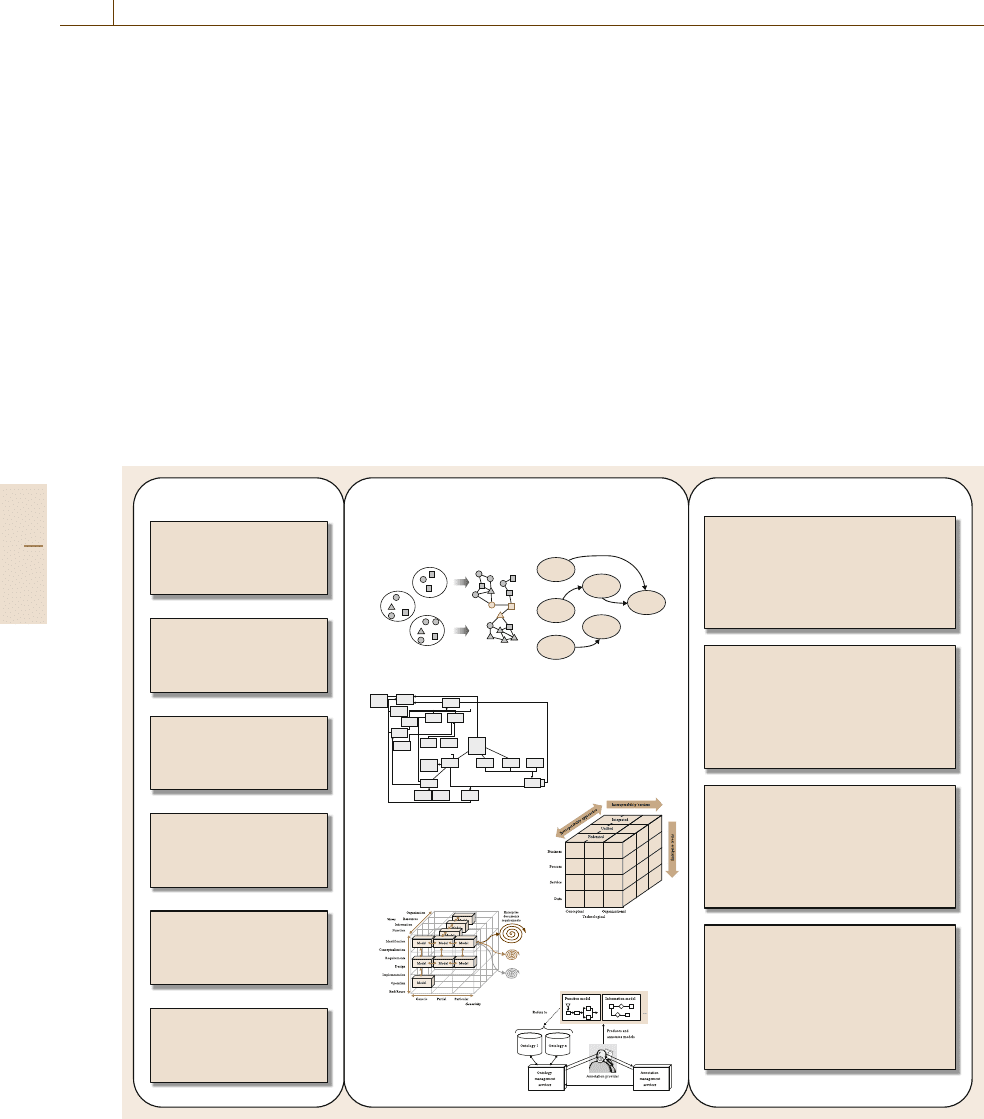Nof S.Y. Springer Handbook of Automation
Подождите немного. Документ загружается.


Enterprise Integration and Interoperability 86.4 Applications and Future Trends 1535
applications across an extended organization with
transactional integrity. It is capable of being adopted
for any general-purpose integration project and can
scale beyond the limits of a hub-and-spoke EAI bro-
ker. Datatransformation isthe abilityto apply XSLT
(extended style sheet transformation) (or XML style
sheets) to XML messages to reformat messages dur-
ing transport depending on the type of receivers
that will consume the messages (for instance, the
ZIP code is a separate information datum for one
application while it is part of a customer address
for another one). Intelligent or rule-based routing
is the ability to use message properties to route
message delivery to different queues according to
message content. Database services simplify access
to database systems using SQL (structured query
language) and Java database connectivity (JDBC)or
object database connectivity (ODBC). Useful enter-
prise integration patterns to be used in messaging
applications can be found in the book by Hohpe
and Woolf [86.4], who have thoroughly analyzed
and described those that are most commonly used
in practice.
6. BPM: Business process management consists of
reviewing, reengineering, and automating business
processes of the organization. Among the process
steps are services offered by IT systems. Once auto-
mated, these processes take the form of workflows.
Two languages can be used to model business pro-
cesses, one at the business user level and one at the
workflow system level. These are:
– BPMN: The business process modeling notation
is a diagrammatic and semistructured notation
that provides businesses with the capability to
represent their internal business procedures in
a graphical language. It gives organizations the
ability to depict and communicate these proce-
dures in a standard manner. Furthermore, the
graphical notation facilitates the understand-
ing of the performance of collaborations and
business transactions between the organizations.
This ensures that business participants will un-
derstand each other and that participants in the
business will enable organizations to adjust to
new internal and B2B business circumstances
quickly [86.22].
– BPEL: The business process execution language
is an XML-based language designed to enable
task sharing for a distributed computing envi-
ronment – even across multiple organizations –
using a combination of web services (BPEL is
also sometimes called BPEL4WS or BPELWS).
It has been written by developers from BEA
Systems, IBM, and Microsoft. BPEL specifies
the business process logic that defines choreog-
raphy of interactions between a number of web
services. The BPEL standard defines the struc-
ture, tags, and attributes of an XML document
that corresponds to a valid BPEL specifica-
tion [86.23]. Conversion mechanisms exist to
translate BPMN models into BPEL specifica-
tions.
86.4 Applications and Future Trends
Enterprise integration has been around in terms of
applications since the beginning of the 1990s, espe-
cially in the domain of manufacturing integration but
also enterprise information integration (EII), enterprise
resources planning (ERP), customer relationship man-
agement (CRM), and then supply chains. The advent of
CORBA, workflow engines, and BPM techniques has
given birth to a range of commercial products, known
as enterprise application integration (EAI) platforms.
Many vendors have proposed solutions, including Iona,
Sopra, Vitria, Tibco, Microsoft BizTalk, HP, IBM, Ora-
cle, and BEA Systems, as well open-source solutions.
Today, nearly all industrial sectors are facing in-
tegration and interoperability problems, ranging from
manufacturing supply chains to banking, the insurance
sector, medical services, and public organizations. The
focus ison XML-based messagingcommunications and
loosely coupled interactions thanks to XML/HTTP and
MOM/ESB techniques. One area that has emerged with
EI and is rapidly growing is electronic commerce (web-
based shopping, B2B commerce, e-Procurement, elec-
tronic payment, EDI, etc.). Major initiatives launched
to sustain this area include ebXML (electronic busi-
ness XML)forXML/EDI (electronic data interchange)
(UN/CEFACT (United Nations Centre for Trade Facil-
itation and Electronic Business) and OASIS (Organi-
zation for the Advancement of Structured Information
Standards)), RosettaNet (www.rosettanet.org)inthe
area of standard electronic data exchange for sup-
ply chains, and Bolero.net (www.bolero.net) proposing
Part I 86.4

1536 Part I Home, Office, and Enterprise Automation
a data and document exchange infrastructure for in-
ternational commerce involving SWIFT (Society for
WorldwideInterbank Financial Telecommunication)for
secured payment.
In terms of current trends that can be observed
there is a shift from the pure business process paradigm
that prevailed through the 1990s to the service-
orientation paradigm. This puts more emphasis on
services interoperability than on IT systems inter-
operability or enterprise application integration than
before [86.25].
Among the future trends, we can mention the
emergence of composite services, i. e., services made
of services. This will rapidly grow both in business
(to combine competencies and capabilities of several
partners into common services) and in government
organizations (for instance, pan-European services of-
Service
Service
Service
Service
Service
Service
Theories, models, languages
and tools
Research challengesDomains
Collaborative
networked
organizations (CNO)
Enterprise modeling
and reference
models
Enterprise and
process
interoperability
Validation and
verification of
enterprise models
Enterprise
application
integration
Enterprise model
repositories
• Hub of integrated e-Services
• Unified enterprise modeling language (UEML)
• Reference,
ontologies, and
functional models
• CNOs reference models
• Theories of collaboration
• Formal methods and tools
• Empirical studies
• UEML for business
applications interoperability
• Ontology for networked
enterprise interoperability
• Semantic interoperability
• Interoperability architectures
• Interoperability process
classification frameworks
• Model repository classification
scheme
• Process definition, execution,
and tracking
• Process analysis, evaluation,
monitoring and optimization
• Process data mining and
visualization
• Collaboration
and bio-inspired
models and tools
Project life cycle
Fig. 86.3 The scope of emerging challenges in enterprise integration and interoperability (after [86.24])
fered to EU citizens where a service offered to citizens
through a common portal will in fact be a combination
of local services running in member states in national
languages, e.g., application for the blue card or Euro-
pean identity card).
At the technical level, integration and interoper-
ability are still evolving and will continue to evolve
with technology (faster communication networks, au-
thentication mechanisms, security issues, electronic
signature, multilingual issues, etc.).
At the semantic level, many researchers agree that
one of the major challenges for integration and interop-
erability remains the semantic unification of concepts.
There are simply too many ontologies around and no
common way of representingthese ontologies, although
OWL-S is a de facto standard. Microtheories have to
emerge to provide sound foundations for the field, and
Part I 86.4

Enterprise Integration and Interoperability References 1537
(XML-based) standards for ontology representation are
needed.
At the organizational level, many techniques and
languages exist to capture and represent business pro-
cesses and services in a satisfactory way for business
users. The research trends should focus on developing
interoperability maturity models with associated met-
rics to assess the level of integration or interoperability
and propose methodologies for improving enterprise in-
tegration or interoperability.
Anyway, for the years to come, the driving forces
imposing the new trends will continue to come from
market globalization and new business conditions: need
for more joint ventures, increased communication, fu-
sion and acquisition, knowledge sharing, or use of
common skills and competencies.
86.5 Conclusion
Thanks to advances in Internet computing and service
orientation, enterprise integration and systems interop-
erability have become a reality that largely contributes
to make enterprises more agile, more collaborative, and
more interoperable. The reader should also see Chap.88
on Collaborative e-Work, e-Business, and e-Service and
Chap.90 on Business Process Automation: CRM, SCM
and ERP for related content.
Enterprise integration and systems interoperability
are fairly mature at the technical level, and will con-
tinue to evolve with new IT technologies, but are not
yet completelyaddressed atthe organizational andmore
specifically at the semantic level.
There are however some other issues (out of the
scope of this chapter) that should be considered. They
concern legal issues, confidentiality issues, or linguistic
aspects, to name a few, especially in the case of in-
ternational contexts (multinational firms, international
organizations or unions of member states). They can
have a political dimension and be even harder to solve
than pure technical or organizational issues mentioned
in this chapter.
References
86.1 F.B. Vernadat: Enterprise Modeling and Integra-
tion: Principles and Applications (Chapman Hall,
London 1996)
86.2 F.B. Vernadat: Interoperable enterprise systems:
principles, concepts, and methods, Annu. Rev.
Control 31(1), 137–145 (2007)
86.3 B. Gold-Bernstein, W. Ruh: Enterprise Integra-
tion: The Essential Guide to Integration Solutions
(Addison-Wesley, Boston 2005)
86.4 G. Hohpe, B. Woolf: Enterprise Integration Pat-
terns: Designing, Building, and Deploying Messag-
ing Solutions (Addison-Wesley, Reading 2004)
86.5 AMICE: CIMOSA: CIM Open System Architecture,2nd
edn. (Springer, Berlin, Heidelberg 1993)
86.6 H. Li, T.J. Williams: A vision of enterprise inte-
gration considerations: a holistic perspective as
shown by the Purdue enterprise reference archi-
tecture, Proc. 4th Int. Conf. Enterp. Integr. Model.
Technol. (ICEIMT’04) (Toronto 2004)
86.7 D. Chen, F. Vernadat: Standards on enterprise in-
tegration and engineering – a state of the art, Int.
J. Comput. Integr. Manuf. 17(3), 235–253 (2004)
86.8 ATHENA: Advanced Technologies for Interoperabil-
ity of Heterogeneous Enterprise Networks and their
Applications, FP6-507312-IST1 Integrated Project
(2005) www.ist-athena.org
86.9 D.S. Lithicum: Enterprise Application Integration
(Addison Wesley, Boston 2000)
86.10 OMG: Common object request broker architec-
ture (CORBA), (Object Management Group 1994)
www.omg.org
86.11 P. Herzum: Web Services and Service-Oriented
Architecture, Executive Rep. 4, No. 10 (Cutter Dis-
tributed Enterprise Architecture Advisory Service,
2002)
86.12 R. Khalaf, F. Curbera, W. Nagy, N. Mukhi, S. Tai,
M. Duftler: Understanding web services. In: Prac-
tical Handbook of Internet Computing,ed.by
M. Singh (CRC, Boca Raton 2004), Chap. 27
86.13 IDAbc: European Interoperability Framework for
Pan-European e-Government Services (European
Commission, Brussels 2003),
www.europa.eu/idabc/
86.14 C4ISR: C4ISR Architecture Framework, V. 2.0, Archi-
tecture Working Group (AWG), (US Department of
Defense (DoD), 1998)
86.15 T.R. Gruber: Toward principles for the design of
ontologies used for knowledge sharing, Int. J.
Human-Comput. Stud. 43, 907–928 (1995)
86.16 World Wide Web Consortium (W3C), OWL-S:
Semantic markup for web services (2004),
www.w3.org/2004/OWL
86.17 World Wide Web Consortium (W3C): XML: eXtensible
mark-up language (2000), www.w3.org/xml
86.18 H. Kreger: Web Services Conceptual Architecture
(WSCA 1.0) (IBM Software Group, Somers 2001)
Part I 86

1538 Part I Home, Office, and Enterprise Automation
86.19 World Wide Web Consortium (W3C): WSDL: Web ser-
vice description language (2001),
www.w3.org/TR/wsdl
86.20 World Wide Web Consortium (W3C), SOAP: Sim-
ple object access protocol (2002), www.w3.org/TR/
SOAP
86.21 D.A. Chappell: Enterprise Service Bus (O’Reilly, Se-
bastopol 2004)
86.22 Business Process Management Initiative (BPMI):
Business Process Modeling Notation (2005),
ww.bpmn.org/
86.23 IBM: Business Process Execution Language for Web
Services (BPEL4WS) (2003),
www.ibm.com/developersworks/library/ws-bpel/
86.24 S.Y. Nof, F.G. Filip, A. Molina, L. Monostori,
C.E. Pereira: Advances in e-Manufacturing, e-
Logistics, and e-Service Systems, Proc. IFAC Congr.
(Seoul Korea 2008)
86.25 A. Molina, H. Panetto, D. Chen, L. Whitman, V. Cha-
purlat, F. Vernadat: Enterprise integration and
networking: challenges and trends, Stud. Inform.
Control 16(4), 353–368 (2007)
Part I 86

1539
Decision Supp
87. Decision Support Systems
Daniel J. Power, Ramesh Sharda
This chapter places decision automation in
a broader context of using information tech-
nologies in decision making. Key definitions
and a brief history of computerized deci-
sion support create important boundaries.
Then a description and explanation of char-
acteristics of computerized decision support
systems (DSS)clarifiesthisapplicationdo-
main. After reviewing management information
needs, a modern taxonomy of decision sup-
port systems is briefly summarized. Issues
associated with building DSS and various ar-
chitectures are reviewed before concluding the
overview.
87.1 Characteristics of DSS ............................1540
87.1.1 Management Information Needs....1540
87.1.2 Communications-Driven
and Group DSS .............................1542
87.1.3 Data-Driven DSS...........................1542
87.1.4 Document-Driven DSS...................1542
87.1.5 Knowledge-Driven DSS .................1543
87.1.6 Model-Driven DSS ........................1543
87.1.7 Secondary Dimensions ..................1543
87.2 Building Decision Support Systems .........1544
87.3 DSS Architecture ...................................1546
87.4 Conclusions..........................................1547
87.5 Further Reading ...................................1547
References ..................................................1548
Decision support systems (DSS) are defined broadly as
interactive computer-based systems thathelp people use
computer communications, data, documents, knowl-
edge, and models to solve problems and make decisions
(see DSSResources.com). DSS are ancillary or auxil-
iary systems; they are not intended to replace skilled
decision-makers. DSS are not automating decision-
making.
In pursuing the goal of improving decision-making,
many different types of computerized DSS have been
built to help decision teams and individual decision-
makers. Some systems provide structured information
directly to managers. Other systems help managers and
staff specialists analyze situations using various types
of quantitative models. Some DSS store knowledge and
make it available to managers. Some systems support
decision-making by small and large groups. Companies
even develop DSS to support the decision-making of
their customers and suppliers.
Table 87.1 identifies some major developments in
the history ofdecision support systems.For more details
see Power [87.1,2].
The history of decision support systems (based
on [87.2]) is relatively brief and the concepts and
Table 87.1 Evolution of DSS concepts
Years Representative DSS Research
1960s Scott Morton’s management decision
support project
Interactive systems research organization
Decision-making theory development
1970s BrandAid research
Alter’s field study
Holsapple research
1980s Key DSS books
Group DSS prototypes
Executive information systems (EIS)
PC expert systems
1990s Business intelligence/OLAP
Data warehousing
Web-based systems/portals
Data mining
Part I 87

1540 Part I Home, Office, and Enterprise Automation
technologies are still evolving. Today, a number of
academic disciplines provide the substantive founda-
tions for decision support systems development and
research. Database research has contributed tools and
research on managing data and documents. Manage-
ment science and operations research have developed
mathematical models for use in building model-driven
DSS and provided evidence on the advantages of mod-
eling in problem solving. Cognitive science, especially
behavioral decision-making research, has provided de-
scriptive and empirical information that has assisted in
DSS design and has generated hypotheses for decision
support research. Some other important fields related
to DSS include artificial intelligence, human–computer
interaction, software engineering, and telecommunica-
tions. In general, the Internet and web have sped up
developments in decision support and have made it hard
to keep up with the rapid changes in DSS capabilities.
In the 1960s, pioneering workin building interactive
systems at the Massachusetts Institute of Technology,
theory development by Simon and colleagues, and Mor-
ton’s [87.3] research created a foundation for building
innovative DSS.
In the early 1970s, BrandAid [87.4] and reports of
Morton’s [87.3] management decision system (MDS)
research demonstrated the feasibility of DSS.Bythe
late 1970s, a number of companies had developed
interactive information systems that used data and mod-
els to help managers analyze semistructured problems.
These diverse systems were all called decision sup-
port systems. Key concept books included those by
Alter [87.5], Sprague and Carlson [87.6], and Bonczek
et al. [87.7].
From those early days, it was recognized that
DSS could be designed to support decision-makers
at any level in an organization. DSS could sup-
port operations, financial management, and strategic
decision-making. Over the years many of the more
interesting DSS have been targeted at middle and
senior managers. DSS are also often designed for spe-
cific types of organizations such as hospitals, banks
or insurance companies. These specialized systems are
sometimes referred to as vertical-market or industry-
specific DSS.
Today, decision support systems are both off-
the-shelf, packaged applications and custom-designed
systems. DSS may support a manager using a single
personal computer or a largegroup of managers in a net-
worked client–server environment. These latter systems
are often called enterprise-wide DSS.
87.1 Characteristics of DSS
Although the term decision support system has many
connotations, based upon Alter’s [87.5] pioneering
research we can identify the following three major char-
acteristics:
1. DSS are designed specifically to facilitate decision
processes.
2. DSS should support rather than automate decision-
making.
3. DSS should be able to respond quicklyto the chang-
ing needs of decision-makers.
Many terms are used for specific types of DSS,
including business intelligence, collaborative systems,
data warehousing, model-based systems, knowledge
management, and online analytical processing. Soft-
ware vendors use these more specialized terms for
both descriptive and marketing purposes. What term
we use for a system or software package is a sec-
ondary concern. Our primary concern should be finding
software and systems that meet a manager’s decision
support needs and provide appropriate management
information.
87.1.1 Management Information Needs
Managers and their support staffs need to consider what
information and analyses are actually needed to sup-
port their management and business activities. Some
managers need both detailed transaction data and sum-
marized transaction data. Most managers only want
summaries of transactions. Managers usually want lots
of charts and graphs; a few only want tables of numbers.
Many managers want information provided routinely
or periodically and some want information available
online and on demand. Managers usually want finan-
cial analyses and some managers want primarily soft,
nonfinancial or qualitative information. Managers have
different needs and wants depending upon personal
preferences, task needs, and information technology
experiences.
Part I 87.1

Decision Support Systems 87.1 Characteristics of DSS 1541
In general, a computerized information system
can provide business transaction summary informa-
tion and can help managers understand many business
operations and performance issues; for example, a com-
puterized system can help managers understand the
status of operations, monitor business results, review
customer preference data, and investigate competi-
tor actions. In all of these situations, management
information and analyses should have a number of char-
acteristics. Information must be both timely and current.
These characteristics mean the information is up to date
and available when managers want it. Also, information
must be accurate, relevant, and complete. Finally, man-
agers want information presented in a formatthat assists
them in making decisions. In general, management in-
formation should be summarized and concise and any
support system should have an option for managers to
obtain more detailed information.
So the subcategory known as decision support sys-
tems needs to provide current, timely information that is
accurate, relevant, and complete. A specific DSS must
present information in an appropriate format that is easy
to understand and manipulate. The information pre-
sented by a DSS may result from analysis of transaction
data or it may be the result of a decision model or it
may have been gatheredfrom externalsources. DSS can
present internal and external facts, informed opinions,
and forecasts to managers. As many others have noted,
managers want the right information, at the right time,
in the right format, and at the right cost. These sys-
tem requirements seem simple and straightforward, but
meeting them remains a challenge.
Technology is creating new decision support capa-
bilities, but much learningand discussionneeds tooccur
to successfully exploit the technological possibilities.
Decision support systems differ in many ways from op-
erating systems that process business transactions. For
example, a popular system that has been widely imple-
mented is called enterprise resource planning (ERP).
ERP is not a decision support system even though the
term suggests thatdecision-making and planningwill be
improved. In general, enterprise resource planning is an
integrated transaction processing system that facilitates
the flow of information between all of the functional ar-
eas of a business. Recently, DSS have been built that
help managers analyze the data from ERP systems, and
ERP systems make it easier to create a wide variety
of DSS.
Decision automation refers to using informa-
tion technologies to make decisions and imple-
ment programmed decision processes. Typically de-
cision automation is considered most appropriate
for well-structured, clearly defined, routine or pro-
grammed [87.8] decision situations. Decision support
systems are intended to help human decision-makers
while decision automation systems make a decision and
reduce the need for immediate human involvement in
the decision. People still write rules and review results
for decision automation, but software makes the routine
decisions.
A major difference between transaction processing
systems, decision automation, and decision support sys-
tems is the general purpose of each type of system.
Transaction processing systems (TPS) are designed to
expedite and automate transaction processing, record
keeping, and simple business reporting of transactions.
Decision automation uses software to make decisions.
Decision support systems are intended to assist in
decision-making and decision implementation. Trans-
action processing is however related to the design of
DSS because transaction databases often provide data
for decision-oriented reporting systems and data ware-
houses. Decision automation often interacts with TPS,
and the results of automated decisions often impact on
TPS.
Transaction processing systems usually provide
standard reports on a periodic basis and support the op-
erations of a company. DSS are used on demand when
they are needed to support decision-making. A man-
ager typically initiates each instance of decision support
system use, either by using the DSS herself or by ask-
ing a staff intermediary to use a DSS. Some managers
and especially clerical employees use transaction pro-
cessing systems to support operations. Line managers
and support staff are the primary users of DSS. TPS
record current information and maintain a database of
transaction information. DSS generally use historical
internal and external data for analysis. DSS may focus
on quantitative analysisand modeling current and future
scenarios. TPS emphasize data integrity and consis-
tency, and although both of these qualities are important
in every system, the primary emphasis for a DSS is
on flexibility and on conducting analyses and retrieving
decision-relevant information and knowledge. Decision
automation routinizes a specific decision 24h a day,
7days a week.
One of the long-standing conclusions from reading
DSS case studies is that DSS can take on many different
forms and can be used in many different ways [87.5].
Decision support systems certainly vary in many ways.
Some DSS focus on accessing data, some on manipulat-
ing models, and some on facilitating communications.
Part I 87.1

1542 Part I Home, Office, and Enterprise Automation
DSS also differ in scope; some DSS are intended for
one primary user and are used stand-alone for analy-
sis, whereas others are intended for many users in an
organization. Also, DSS differ in terms of who uses
a specific system; for example, some DSS are used by
actual decision-makers and some are used by interme-
diaries such as marketing analysts or financial analysts.
If a computerized system is not a transaction processing
system and if a manager uses it, many observers will be
tempted to call the system a DSS.
Some examples show the wide variety of DSS ap-
plications. Major airlines have DSS used by analysts
for many tasks including pricing and route selection.
Many companies have DSS that aid in corporate plan-
ning and forecasting. Specialists often use these DSS
that focus on financial and simulation models. DSS can
help monitor costs and revenues and track departmental
budgets. Also, investment evaluation and support sys-
tems are increasingly common. Frito-Lay has a DSS
that aids in pricing, advertising, and promotion. Route
salesmen use handheld computers to support decision-
making activities.
Many manufacturing companies use manufactur-
ing resources planning (MRP) software. This spe-
cific operational-level DSS supports master production
scheduling, purchasing, and materials requirements
planning. More recent MRP systems support what-
if analysis and simulation capabilities. DSS support
quality improvement and control decisions. Monsanto,
FedEx, and most transportation companies use DSS
for scheduling trucks, airplanes, and ships. The Coast
Guard uses a DSS for procurement decisions. Com-
panies such as Wal-Mart have large data warehouses
and usedata-mining software. Businessintelligence and
knowledge management systems are increasingly com-
mon. On the World Wide Web one can find DSS that
help track and manage stock portfolios, choose stocks,
plan trips, and suggest gifts. DSS support distributed
decision activities using groupware and a corporate in-
tranet.
The following expanded DSS framework helps cat-
egorize the most common DSS currently in use [87.1,
9, 10]. Some DSS are integrated or hybrid systems
with more than one major DSS subsystem. The frame-
work focuses on one major capability dimension with
five categories and three secondary dimensions. The
term driver is used as a common or shared descrip-
tive adjective in the expanded framework. Driver refers
to the capability, tool or component that is providing
the dominant functionality in the DSS. The five cat-
egories explained below are communications-driven,
data-driven, document-driven, knowledge-driven, and
model-driven.
87.1.2 Communications-Driven
and Group DSS
Group decision support systems (GDSS) and group-
ware were investigated in the mid-1980s, but now
a broader category of communications-driven DSS can
be identified. This type of decision support system
includes communication, collaboration, and decision
support. A group DSS is an interactive computer-based
system intended to facilitate the solution of prob-
lems by decision-makers working together as a group;
such systems often derive functionality from a model
more than from supporting collaboration and hence
are model-driven DSS. Groupware supports electronic
communication, scheduling, document sharing, and
other group productivity and decision support enhanc-
ing activities. A number of technologies and capabilities
are included in this category in the framework: some
collaborative group DSS, two-way interactive video,
white boards, bulletin boards, chat, and email systems.
87.1.3 Data-Driven DSS
Data-driven DSS emphasize analysis of data. These
systems include file drawer and management reporting
systems, data warehousing and analysis systems, exec-
utive information systems (EIS), and data-driven spatial
decision support systems (SDSS). EIS are targeted at
senior managers and SDSS display spatial data for de-
cision support. Business intelligence (BI) systems are
also examples of data-driven DSS. A data-driven DSS
provides access to and manipulation of large databases
of structured data and especially a time series of in-
ternal company data and external data. Simple file
systems accessed by query and retrieval tools provide
the most elementary level of functionality. Data ware-
house systems that allow the manipulation of data by
computerized tools tailored to a specific task and set-
ting or by more general tools and operators provide
additional functionality. Data-driven DSS with online
analytical processing (OLAP) provide the highest level
of functionality and decision support that is linked to
analysis of large collections of historical data [87.11].
87.1.4 Document-Driven DSS
A new type of DSS,adocument-driven DSS,isevolv-
ing to help managers retrieve and manage unstructured
Part I 87.1

Decision Support Systems 87.1 Characteristics of DSS 1543
documents and web pages. A document-driven DSS in-
tegratesa variety of storage and processing technologies
to provide complete document retrieval and analysis.
The web provides access to large document databases
including databases of hypertext documents, images,
sounds, and video. Examples of documents that would
be accessed by a document-driven DSS are policies
and procedures, product specifications, catalogs, and
corporate historical documents, including minutes of
meetings, corporate records, and important correspon-
dence. A search engine is a powerful decision-aiding
tool associated with a document-driven DSS. Some au-
thors call this type of system a knowledge management
system.
87.1.5 Knowledge-Driven DSS
The terminology for this fourth category of DSS is
still evolving. Currently, the best term seems to be
knowledge-driven DSS. Sometimes it seems equally ap-
propriate to use Alter’s [87.5] term suggestion DSS
or the narrower term management expert system.
Knowledge-driven DSS suggest or recommend actions
to managers. These DSS have specialized problem-
solving expertise. The expertise consists of knowledge
about a particular domain, understanding of problems
within that domain, and skill at solving some of these
problems.
87.1.6 Model-Driven DSS
A fifth category, model-driven DSS, includes systems
that use accounting and financial models, representa-
tional models, and optimization models. Model-driven
DSS emphasize access to and manipulation of a quan-
titative model. Simple statistical and analytical tools
provide the most elementary level of functionality.
Some OLAP systems that allow complex analysis of
data may be classified as hybrid DSS systems providing
modeling, data retrieval, and data summarization func-
tionality. Model-driven DSS use data and parameters
provided by decision-makers to aid them in analyzing
a situation, but they are not usually data intensive. Very
large databases are usually not needed for model-driven
DSS, but data for a specific analysis may need to be
extracted from a large database.
87.1.7 Secondary Dimensions
The secondary dimensions used to describe DSS
include purpose, targeted users, and the enabling tech-
nology. A relatively new category of DSS made
possible by new technologies and the rapid growth
of the public Internet is interorganizational DSS.
These DSS target a company’s customers or suppli-
ers. The public Internet is creating communication
links for many types of interorganizational systems,
including DSS. An interorganizational DSS provides
external stakeholders with access to a company’s in-
tranet and authority or privileges to use specific DSS
capabilities. Companies can make a data-driven DSS
available to suppliers or a model-driven DSS avail-
able to customers to design a product or choose
a product. Most DSS are intra-organizational DSS
that are designed for use by managers in a company
as stand-alone DSS or for use by a group of man-
agers in a company as a group or enterprise-wide
DSS.
Many DSS are designed to support specific busi-
ness functions or types of businesses and industries.
These are broad- or narrow-purpose DSS.SuchDSS
can be labeled as function-specific or industry-specific
purpose DSS.
A function-specific DSS such as a budgeting sys-
tem may be purchased from a vendor or customized
in-house using a more general-purpose development
package. Vendor developed or off-the-shelf DSS sup-
port functional areas of a business such as marketing
or finance; some DSS products are designed to sup-
port decision tasks in a specific industry such as a crew
scheduling DSS for an airline. A function or task-
specific DSS has an important purpose in solving
a recurring decision task. Function- or task-specific
DSS can be further classified and understood in terms
of the dominant DSS component in the DSS.So,
a function-specific DSS may be model driven, data
driven, document driven or knowledge-driven. These
DSS have capabilities relevant for a decision about
some function that an organization performs (e.g.,
a marketing function or a production function). These
DSS are categorized by purpose: function-specific DSS
help a person or group accomplish a specific deci-
sion task; general-purpose DSS software helps support
broad tasks such as business performance monitoring,
businessintelligence, projectmanagement, anddecision
analysis.
All five broad categories of decision support sys-
tems can be implemented using web technologies.
When the enabling technology used to build a DSS
is the Internet and web is seems appropriate to call
the system a web-based DSS.Aweb-based DSS is
a computerized system that delivers decision support
Part I 87.1

1544 Part I Home, Office, and Enterprise Automation
Table 87.2 An expanded DSS framework (after [87.1])
Dominant DSS User groups: Purpose: Enabling
component internal, external general, specific technology
Communications Internal teams, Conduct a meeting Web or
Communications-driven DSS now expanding Bulletin board client/server
Help users collaborate
Database Managers, staff, Query a data Main frame,
Data-driven DSS now suppliers warehouse client/server,
web
Document base Specialists and Search web pages, Web
Document-driven DSS user group is expanding find documents
Knowledge base Internal users, Management advice, Client/server, web
Knowledge-driven DSS now customers choose products
Models Managers and staff, Crew scheduling Stand-alone PC
Model-driven DSS now customers Decision analysis
information or decision support tools to a manager or
business analyst using a thin-client web browser such
as FireFox or Internet Explorer [87.1]. The computer
server that is hosting the DSS application is linked
to the user’s computer by a network with the trans-
mission control protocol/Internet protocol (TCP/IP).
In many companies, a web-based DSS is synony-
mous with an intranet or enterprise-wide DSS.Web
technologies are powerful tools for creating decision
support systems and especially interorganizational DSS
that support the decision-making of customers and
suppliers. Web 2.0 technologies are the leading edge
for building DSS,butsomeDSS will continue to
be built using mainframe and client–server enabling
technologies.
Column one of Table 87.2 lists the five broad
categories of decision support systems that differ in
terms of the dominant decision support component, in-
cluding communications-driven DSS, data-driven DSS,
document-driven DSS, knowledge-driven DSS,and
model-driven DSS. The table provides examples of
targeted user groups – intra-organizational and interor-
ganizational, purpose, and enabling technologies.
One can use the dominant DSS architecture com-
ponent, targeted user group, purpose, and the enabling
technology to describe a specific decision support sys-
tem. For example, a manager may want to build
a model-driven, intra-organizational, product design,
web-based DSS to support a specific business decision
process.
87.2 Building Decision Support Systems
Traditionally, information systems academics and prac-
titioners have discussed building decision support
systems in terms of four major components:
1. The user interface
2. The database
3. The models and analytical tools
4. The DSS architecture and network [87.6].
This traditional list of components remains useful be-
cause it identifies similarities and differences between
categories or types of DSS and it can help managers
and analysts build new decision support systems. The
expanded DSS framework [87.1, 9, 10] is based on the
different emphases placed on DSS components when
a specific system is actually constructed (Fig.87.1).
Data-driven, document-driven, and knowledge-
driven DSS need specialized database components.
A model-driven DSS may use a simple flat-file
database with fewer than 1000 records, but the model
component is very important. Experience and some
Part I 87.2
